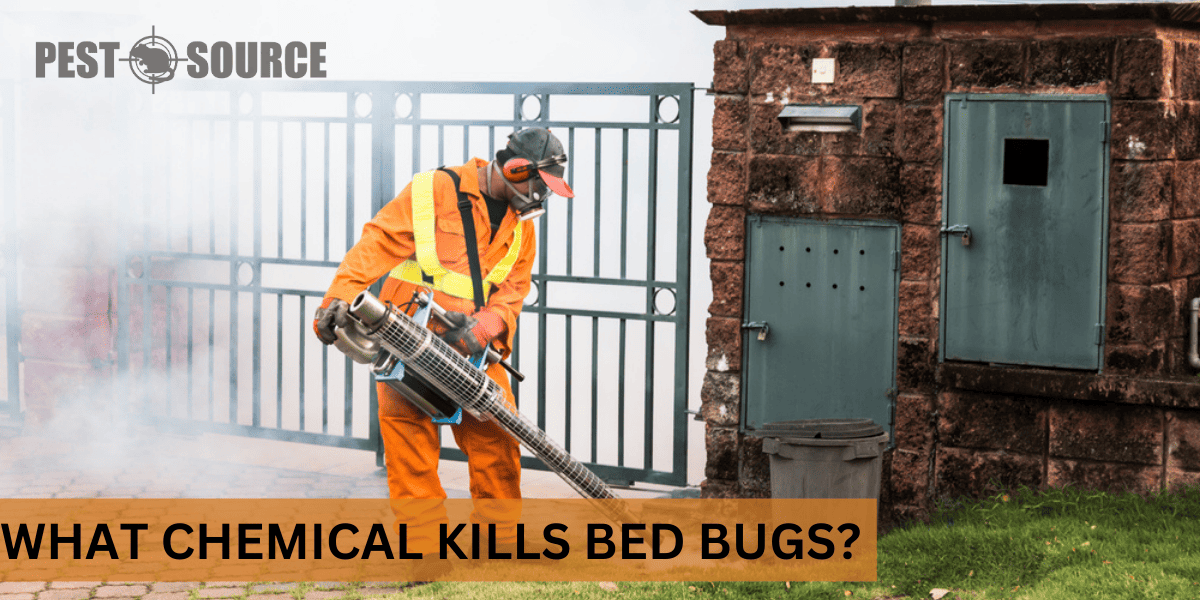Pesticides containing chemicals such as pyrethrins, pyrethroids, and desiccants are known to be effective at killing bed bugs. Each chemical works differently, targeting the bugs’ nervous system or dehydrating them. Read on to understand the specific chemicals approved for bed bug control and how to safely use them in your eradication efforts.
POINTS
- Bed bugs can be effectively managed and eliminated using a variety of chemical treatments, including pyrethrins, pyrethroids, desiccants, insect growth regulators, fumigants, and newer chemicals like neonicotinoids and Chlorfenapyr.
- Chemical resistance in bed bugs is a growing concern as overuse of a single type of chemical can lead to bugs developing immunity to it. Alternating chemicals and using a mix addresses this issue by targeting the bugs in different ways.
- Over-the-counter chemical treatments can help with minor infestations, but larger or more persistent infestations often require professional pest management services. Such professionals integrate chemical and non-chemical treatments for a comprehensive bug control strategy.
- Although these chemicals are designed to be harmful to bed bugs, they can also pose potential risks to humans and pets. It’s crucial to follow manufacturer’s instructions, use personal protective equipment, ensure good ventilation, and keep children and pets away from treated areas.
- A successful bed bug control strategy includes early detection, thorough cleaning, careful application of a mix of appropriate chemicals, and often, professional intervention. An Integrated Pest Management approach that combines chemical and non-chemical methods is often the best strategy to prevent and eradicate bed bug infestations.
Chemical Solution for Bed Bugs
What is the importance of chemical treatments for bed bug infestations?
Once a bed bug infestation takes hold, it can be incredibly tough to get rid of. Despite attempts to clean your home thoroughly or get rid of contaminated furniture, these bugs are determined survivors and will often return if not thoroughly eliminated.
Chemicals provide a targeted approach, specifically designed to strike at the heart of the bed bug lifecycle: from halting their growth with insect growth regulators, to destroying their eggs with fumigants. Done correctly, a chemical approach can effectively break the bed bug life cycle, offering a chance to rid your home of these irritating pests for good.
Pyrethrins and Pyrethroids: Are They Effective Bed Bug Killers?
How do pyrethrins and pyrethroids work to kill bed bugs?
Pyrethrins are naturally occurring compounds that are derived from chrysanthemum flowers, while pyrethroids are their synthetic counterparts. Both these chemicals work by disrupting the nervous system of the bed bugs. The resulting neurotoxic effect paralyzes the bugs, ultimately leading to their death.
What is the effectiveness of pyrethroids for bed bugs?
Pyrethroids are indeed effective in killing bed bugs. However, their efficiency may have dropped over the past years due to the increasing resistance that many bed bug populations have developed against these chemicals. Still, when used in combination with other chemicals or heat treatments, pyrethroids can help in managing a bed bug infestation.
What is the difference between pyrethrins and pyrethroids and how do they affect bed bugs?
As mentioned, pyrethrins are natural insecticides derived from chrysanthemum flowers, while pyrethroids are their synthetic equivalent. Both chemicals work in a similar fashion when it comes to killing bed bugs. However, pyrethroids usually have a longer-lasting effect, which enhances their potency and makes them more suitable for large-scale infestations. However, pyrethrins have the advantage of being less likely to induce resistance in bed bugs, mainly because they break down quickly in the environment.
Understanding Desiccants: Are They a Permanent Solution for Bed Bug Infestations?
How do desiccants work to kill bed bugs?
Desiccants are a different kind of insecticide that isn’t designed to poison bugs but rather to dry them out. They achieve this by damaging the outer waxy layer of bed bugs, which in turn causes them to dehydrate and die. Common desiccants used against bed bugs include diatomaceous earth and boric acid.
Are desiccants effective in killing bed bugs permanently?
While desiccants have proven to be quite effective against bed bugs, using them as a lone strategy might not guarantee a permanent solution to the infestation. The process tends to be slow as it relies on the bugs crossing the path of the desiccant in order for it to work. Also, bed bugs are adaptative and may avoid areas treated with desiccants. However, when used in combination with other chemical treatments or heat, desiccants can play a crucial role in comprehensive bed bug control strategies.
How Do Insect Growth Regulators Contribute to Bed Bug Control?
How do insect growth regulators work to interrupt the bed bug life cycle?
Insect Growth Regulators (IGRs) function differently from other insecticides. They do not directly kill pests, instead, they disrupt the bed bug life cycle, impeding their growth and maturity. This is done by mimicking insect hormones and disturbing their normal developmental process, effectively stunting their lifecycle and preventing new generations from forming.
How effective are insect growth regulators for permanent bed bug control?
While IGRs do not directly kill adult bed bugs, they are extremely effective in halting infestations in the long run by disrupting the reproductive process. It might take a bit more time for the effects to be visible, but IGRs pave the way for a long-term, permanent solution against bed bug infestations. When used in conjunction with other chemicals that kill adult bugs, you have the workings of an effective eradication plan.
Fumigants: A Chemical Solution for Bed Bug Eggs?
How do fumigants work to kill bed bugs and their eggs?
Fumigants are chemicals that turn into gas at room temperature, allowing them to penetrate deeply into materials where bed bugs hide. The gas seeps into the cracks and crevices, reaching bed bugs, and their eggs that would usually be inaccessible to other treatments.
What is the effectiveness of fumigants like Sulfuryl fluoride against bed bugs and their eggs?
Sulfuryl fluoride, a commonly used fumigant, effectively eliminates bed bugs in all life stages, including resilient eggs. While fumigation can be an effective method of treating large-scale infestations, its success significantly depends on the proper execution of the procedure. This often necessitates professional assistance to ensure the gas reaches all hiding spots and colonies.
How Do Neonicotinoids and Chlorfenapyr Aid in Bed Bug Eradication?
How do Neonicotinoids work against bed bugs?
Neonicotinoids are a newer class of insecticides modeled after nicotine. They act on the bed bugs’ nervous system by causing their nerve cells to fire continually, ultimately leading to paralysis and death. Neonicotinoids are particularly effective because, unlike pyrethroids, bed bugs have not developed resistance to them.
How does Chlorfenapyr function to kill bed bugs?
Chlorfenapyr is a non-repellent, meaning bed bugs do not recognize it as a threat, thereby reducing resistance issues. It disrupts the bed bugs’ basic metabolic functions, forcing them into a state of inactivity, which leads to death.
Are Neonicotinoids and Chlorfenapyr effective in dealing with bed bug infestations permanently?
Neonicotinoids and Chlorfenapyr can be very effective in managing bed bug infestations, especially when used as part of an integrated pesticide management approach. Combining them with other methods such as heat treatments, IGRs, and desiccants, can offer a more comprehensive and robust solution for ridding your home of bed bugs permanently.
What Chemical Treatments Are Effective at Killing Bed Bugs Permanently?
What factors contribute to a chemical’s effectiveness against bed bugs?
Several factors can determine a chemical’s effectiveness against bed bugs. These may include the concentration of the chemical used, how it’s applied, the life stage of the bed bugs (adult, nymph or egg), the specific species of bug (as some have developed resistance against certain chemicals), and the regularity of application.
Can a combination of chemicals provide a permanent solution to bed bugs?
Absolutely. Utilizing a combination of chemicals that affect bed bugs differently can often result in a more effective treatment. With a combination, you’re not only attacking adult bed bugs but also halting their development and reproduction, providing a more holistic solution.
Which methods or chemicals are most effective for killing bed bugs permanently?
When combined with careful mechanical removal of bed bugs (such as vacuuming and hot washing bedding), the use of multiple chemicals like pyrethroids, desiccants, and neonicotinoids can be highly effective. It’s also crucial to include IGRs in your arsenal to disrupt the bed bug life cycle and fumigants for penetrating hidden breeding areas. Remember, the correct and safe application of these chemicals is paramount, so always consider enlisting the help of professional exterminators.
What Products are Available for Personal Use to Kill Bed Bugs?
What are the commercially available chemical products or brands used to eradicate bed bugs?
Multiple commercial products are available to help you combat a bed bug infestation. Some of these include EcoRaider, Bedlam Plus, and JT Eaton Kills Bed Bugs Plus. These contain various active ingredients such as pyrethroids, neonicotinoids, and desiccants.
How effective are these products at killing bed bugs and their eggs?
When used correctly, these products are indeed effective at killing bed bugs and potentially their eggs. However, remember that they are part of the solution and a complete eradication often requires a comprehensive approach, including cleaning, heat treatment and physical removal.
Are there best-rated insecticides or pesticides for bed bugs?
Each individual situation can dictate what product will be the most effective. However, products containing neonicotinoids like imidacloprid or desiccants like diatomaceous earth have been well-rated.
What sprays are available for killing bed bugs?
There are numerous sprays on the market such as Proof Bed Bug Spray, Ortho Home Defense Bed Bug Killer, and Harris Bed Bug Spray. These products come in easy-to-use spray bottles or aerosol cans, and many contain pyrethroids or neonicotinoids which are effective against bed bugs. Always read and follow the directions carefully to ensure safety and effectiveness.
Chemical Resistance in Bed Bugs: A Growing Concern?
How have bed bugs developed resistance against certain chemicals?
Over time, bed bugs have shown a great potential to develop resistance to chemicals that are commonly used against them. This resistance happens through natural selection. Some bed bugs naturally possess traits that make them resistant to a certain chemical. These bugs survive the application of the insecticide, reproduce, and pass on their resistance to their offspring. As a result, the population of bugs that are unaffected by the insecticide grows, rendering the chemical less effective over time.
How can alternating chemicals help to prevent resistance in bed bugs?
Alternating chemicals is a strategy that’s often used to circumvent resistance. A population of bed bugs may develop resistance to one chemical, but it’s unlikely they will simultaneously develop resistance to a different chemical that affects them in a different way. By alternating the types of insecticide used, we can outmaneuver the bugs and prevent them from becoming entirely invulnerable to chemical treatments.
How to prevent bed bugs from developing resistance against certain chemicals?
Using an Integrated Pest Management (IPM) approach can help reduce the chances of bed bugs developing resistance. This includes applying a mix of chemical and non-chemical interventions, implementing regular inspections, and monitoring for early identification of re-infestations. Additionally, ensuring that a single type of chemical isn’t overused can slow down the pace at which resistance develops.
The Role of Pest Control Professionals in Bed Bug Management
What chemicals do exterminators use to kill bed bugs?
Exterminators generally use a combination of chemicals including pyrethroids, neonicotinoids, desiccants, IGRs and sometimes, fumigants, depending on the severity of the infestation. Professional treatment often offers faster, more reliable results.
How do professionals ensure the extermination of both bed bugs and their eggs?
Professional exterminators employ a range of tactics, backed by their expertise and high-grade chemicals that laypersons might not have access to. They have reliable methods for detecting bed bugs, including canine scent detection units, and use a combination of treatments from whole-house heating to targeted application of chemicals to ensure adult bugs, nymphs, and eggs are all effectively eradicated.
When is it necessary to consult with professional pest control services for bed bug infestations?
DIY treatments can be effective for small, localized infestations; however, for a more rapid, complete, and lasting resolution, especially for larger infestations, it is advisable to seek the help of a professional. Bed bugs are elusive, reproduce quickly, and survive many conventional treatments, so professional pest control services can provide an aggressive and comprehensive treatment plan.
Safety Considerations when Using Chemicals to Treat Bed Bugs
What potential harm can these chemicals cause to humans and pets?
While effective against bed bugs, it’s important to remember that these chemicals can potentially pose risks to human health and pets. Symptoms like skin and eye irritation, nausea, headaches, dizziness, and in severe cases, seizures or tremors can occur from exposure.
How to use chemical products safely when treating bed bugs?
When treating for bed bugs with chemicals, always follow the manufacturer’s instructions. Use all necessary personal protective equipment, such as gloves and masks. Also, ensure good ventilation during and after the application, and keep pets and children away from the treated area until it’s safe to return.
What precautions need to be taken when using chemicals to kill bed bugs?
Apart from the precautions above, never mix chemicals unless directed to by the label. Also, be mindful not to apply more than necessary; this will not only help to prevent potential health risks but also avoid any unnecessary harm to the environment.
What precautions do pest control companies take while using chemicals?
Professional exterminators are trained in handling and application of these chemicals. They follow strict safety protocols, using protective equipment, and implementing measures to protect you, your family, and pets. They are well-versed in the careful application of chemicals, ensuring that they target the bugs without causing undue exposure or harm to the household’s inhabitants.
What Kills Bed Bugs Instantly?
To kill bed bugs instantly, chemical insecticides containing pyrethroids or pyrethrins are often used. These substances, when applied directly to the insects, can disrupt their nervous systems, leading to rapid death. However, due to growing resistance among bed bug populations, these chemicals may not always be effective. It is important to note that while these methods can instantly kill bed bugs, a comprehensive approach is necessary to eliminate an infestation.



